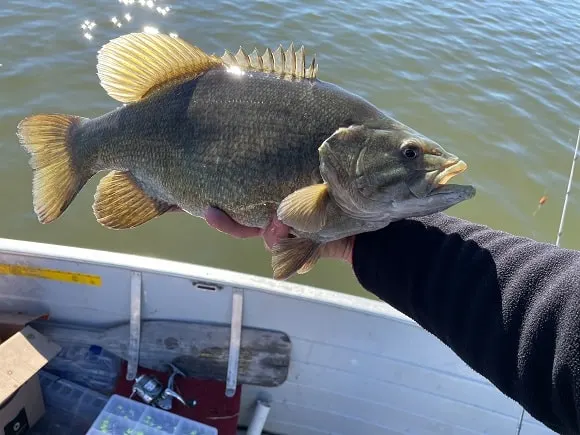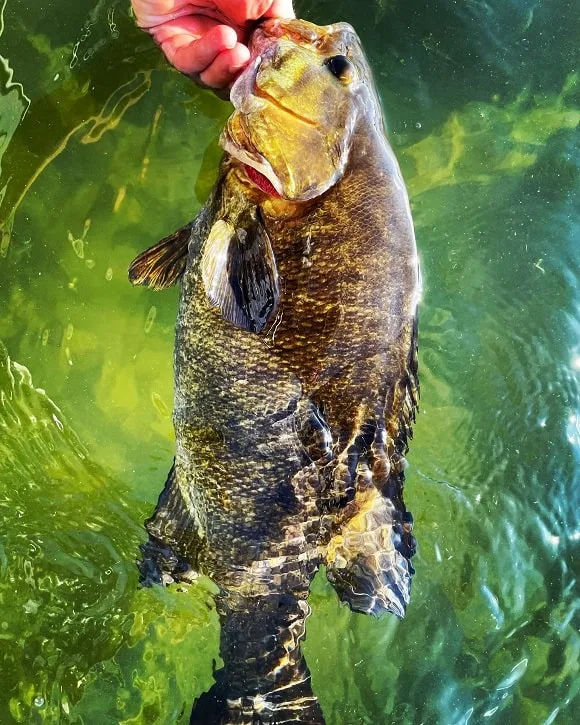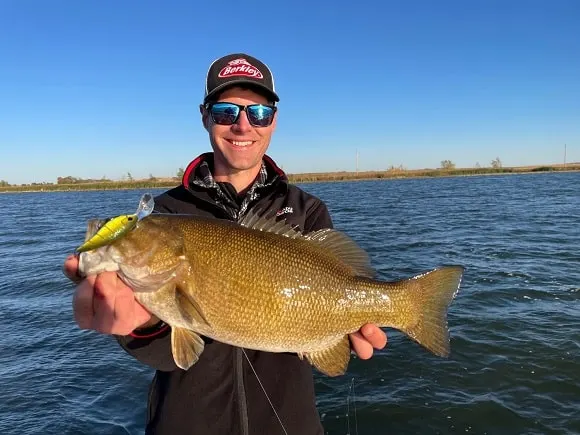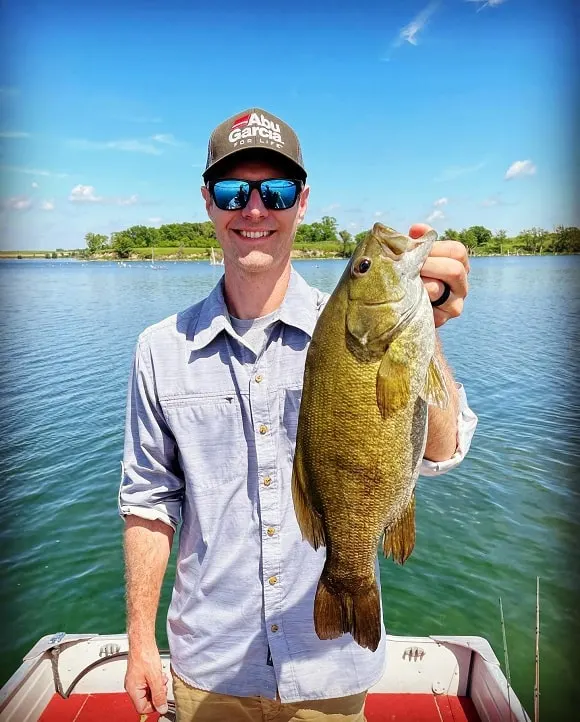Smallmouth bass are one of America’s top freshwater predators and most popular game fish.
I wanted to learn more about their diet and preferred forage, so I decided to write this article on the favorite prey and baits of smallmouth bass.
Smallmouth bass mainly prey on small fish like minnows, shads, and chubs. They also love to eat crayfish, insects, and tadpoles. Cannibalism among juvenile and adult fish is common in waters with low food abundance and high competition from other predators.
Keep reading and find out more about the varied diet of smallmouth bass and why some populations love round goby. You can also check out the very best bait and lure picks for smallies in this article!
PRO TIP: Need to gear up for your next bass fishing adventure? Then check out this awesome rod and reel combo on Amazon.
It’s decently priced, very durable, and will catch you plenty of trophy smallmouths!
What Types of Fish Do Smallmouth Bass Eat?

Adult smallmouth bass (Micropterus dolomieu) are top predators that eat a wide variety of fish.
Due to their relatively small size, smallmouths limit their diet to smaller prey fish or juvenile fish of the following species:
- minnows
- darters
- bluegill
- pumpkinseed
- yellow perch
- warmouth
- green sunfish
- shad
- sculpins
- round gobies
According to research, the diet of smallmouth bass is often closely related to that of largemouth bass, at least in water systems where both species can be found.
These similar diet patterns often lead to closely related growth rates of the two bass types, up to the maximum size of smallmouth bass.
Another highly interesting study has shown that smallmouth bass tend to feed on salmonid juveniles in river systems inhabited by smallmouth bass and salmon and trout types.
The study sampled smallmouth bass in the Columbia River (Washington) and found that juvenile salmonids made up 59% of the bass’ diet and were found in 65% of the stomachs of smallmouth bass. That’s pretty substantial!
Predation on those young salmonids was highest during spring and early summer, as the salmons’ young are abundant and of suitable forage size this time of year.
In other words, a regular feast for the Columbia River’s bass!
This clearly shows that smallmouths are apex predators that can adapt to their environment.
Do Smallmouth Bass Eat Insects?
Both juvenile and adult smallmouth bass eat a variety of terrestrial and aquatic insects.
While the young fish mostly keep to eating zooplankton and the smallest of aquatic insects, bigger fish tend to go after the bigger insect types.
These can include:
- dragonfly nymphs
- beetles
- grasshoppers
- mayflies
- caterpillars
- midges
- caddisflies
- stoneflies
Especially during summer or in waters that do not have an abundance of other forage sources, smallmouths tend to eat plenty of insects.
As mentioned above, they are highly adaptable and opportunistic feeders.
Do Smallmouth Bass Eat Crayfish?

This might come as a surprise to many bass anglers, but smallies love crayfish! They simply can’t get enough of them.
Studies have shown that crayfish can make us as much as 50% of the bass’ diet in waters with abundant crayfish populations.
In some lakes with small populations of forage fish, crayfish even made up around 80% of the smallmouths’ stomach content.
Another interesting fact in this regard is the example of Lake Erie.
50% of the lake’s smallmouth population’s diet consisted of crayfish until the round goby started to invade the water system.
After the invasion, the goby made up around 75% of the bass’ diet, and crayfish was down to about 15 to 20%.
These two forage sources make a lot of sense if you check their protein content. Crayfish contain about 15% protein, and round goby have as much as 18 to 20%.
In other words, those are some very rich snacks for the smallmouth bass!
And when it comes to crayfish, anglers can take a lot of advantage of this fact as well, as these crustaceans can be regular super baits in certain waters!
No matter if you use live crayfish (if legal), crayfish meat, or softbaits imitating crayfish; if you want to try out a new type of bait, why not use this one on your next bass fishing trip?
Furthermore, smallmouth bass also occasionally eay other crustaceans such as freshwater shrimps and scuds.
Do Smallmouth Bass Eat Frogs?
Grown frogs aren’t typically on the smallmouth’s menu, although they will devour the occasional topwater frog (both the natural and lure type).
On the other hand, Tadpoles are a favorite of smallmouth bass, partly because of their size and their nutritious values.
Smallmouth bass have relatively small mouths (surprise), and devouring and swallowing large prey is difficult for them.
Tadpoles have the perfect size for their mouths, and they can swallow a few at once.
And as crayfish and round goby, tadpoles are an excellent source of protein, which smallies need to grow big and strong.
Are Smallmouth Bass Cannibals?

Smallmouth bass are cannibalistic and will eat their own. While cannibalism is only occasionally observed among larval and juvenile smallmouths, adult fish can be extremely cannibalistic.
As always in the world of fish, food abundance and competition for food are the two main driving factors for cannibalistic behavior within any given population and habitat.
The fewer food sources available for the young, the more the juveniles will predate on larval smallmouth bass.
Similarly, adult fish will turn cannibalistic if there aren’t enough forage fish around or if the competition for them by other top predators is too high.
Larval or fry-stage smallmouth bass are simply a food source that’s too good to ignore, as they are abundant and easily accessible.
Research has also shown that cannibalism positively affects the growth rate of the cannibals.
Unfortunately, it also negatively affects recruitment, so overall population growth is often disturbed and slowed whenever cannibalism among smallmouth bass occurs in a habitat.
What Is the Best Bait for Smallmouth Bass?

You can catch smallies on a variety of baits and lures.
Baits
Some of the most productive live baits for smallmouth bass are the ones that are naturally found in their habitat.
Those often include the following:
- minnows
- shads
- gobies
- chubs
- crayfish
Additionally, you can also catch them on nightcrawlers and leeches.
Most anglers prefer chubs, shads, and minnows, as they are readily available and work wonders on the water. Smallies love them!
And then there’s crayfish! Whether as live bait or dead bait, you should most certainly give them a try when targeting smallmouths, especially if live baitfish do not produce any bites!
As discussed above, crayfish are often the preferred prey of smallmouth bass, and if they occur in the lake or river you’re fishing, chances are good that they can become your secret weapon for trophy smallies.
Do not underestimate the power of the crayfish!
Lures
There are also plenty of lures that you can catch smallmouth bass on.
Here are a few of the most commonly used types:
- crankbaits
- creature baits
- spinnerbaits
- swimbaits
- buzzbaits
- chatterbaits
- jigs
- topwater poppers
While most patterns and shapes will work, it’s always a good idea to match the hatch!
Cranks that look and move like minnows, shads, gobies, or chubs are never wrong picks!
And if you happen to find some creature baits that look like (you guessed it) crayfish, you’re apt to be king of the lake!
Here is a selection of some of the best lure models for smallmouths. You can find all of them on Amazon if you want to take a closer look:
What Other Fish Eat Smallmouth Bass?
Young smallmouth bass in the larval and fry stage are preyed upon by many predators.
The most common include:
- smallmouth bass
- largemouth bass
- yellow perch
- walleye
- musky
- lake trout
- northern pike
- sunfishes
The bigger they get, the fewer natural enemies they’ll have.
Nevertheless, larger apex predators like pike, musky, and big walleye still won’t have a problem gulping down smallmouth bass weighing several pounds.
Essential Gear Tips
If you’re looking for solid and reliable bass fishing gear, these tips might be useful for you.
This gear and tackle is of top quality and sells at a very decent price on Amazon:
A solid and popular all-round spinning rod! This rod is lightweight, has great sensitivity, and phenomenal action. Fits both beginners and seasoned bass pros. A 6’6” or 7′ Medium rod is your best pick for smallies.
Pflueger President Spinning Reel
An affordable high-performance spinning reel that’s perfect for smallmouth bass. Pflueger spells high quality and awesome durability! Makes for a great bass combo together with Ugly Stick. A Size 30 or 35 is a solid pick for smallmouths!
One of the best braids available today. Zero stretch, great feel, and immense strength make this line the perfect pick for bass in both open and snaggy waters. Put on a 15 to 20lb test, and you’re good to go!
Related Articles
- What Time of Year Do Smallmouth Bass Spawn?
- How Big Do Smallmouth Bass Get? (With World Record Weight)
- What Is the Biggest Largemouth Bass Ever Caught?
Featured image courtesy of Dan Spengler





